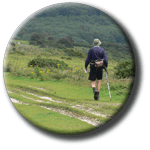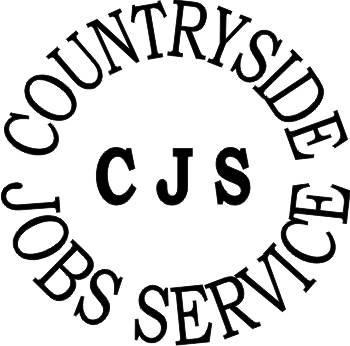Naturenet: Rights of Way Definitive Maps
Rights of Way
Definitive Maps
T
 he information in this section is based on "A Guide to Definitive Map
Procedures" available from the Countryside
Agency
he information in this section is based on "A Guide to Definitive Map
Procedures" available from the Countryside
Agency .
This booklet is free. The web version was partly copied from a page by
Mike Cattell (no longer online that we can find).
.
This booklet is free. The web version was partly copied from a page by
Mike Cattell (no longer online that we can find).
 A definitive map is a map prepared by a surveying
authority which is a legal
record of the public's rights of way in one of four categories (footpath,
bridleway, road used as a public path or byway open to all traffic). If a
way is shown on the map, then that is legal, or conclusive, evidence that
the public had those rights along the way at the relevant
date of the map
(and has them still, unless there has been a legally authorised change).
But the reverse is not true. So the showing of a way as a footpath does not
prove that there are not, for example, additional unrecorded rights for horseriders
to use the way. Nor is the fact that a way is not shown at all on the definitive
map proof that the public has no rights over it.
A definitive map is a map prepared by a surveying
authority which is a legal
record of the public's rights of way in one of four categories (footpath,
bridleway, road used as a public path or byway open to all traffic). If a
way is shown on the map, then that is legal, or conclusive, evidence that
the public had those rights along the way at the relevant
date of the map
(and has them still, unless there has been a legally authorised change).
But the reverse is not true. So the showing of a way as a footpath does not
prove that there are not, for example, additional unrecorded rights for horseriders
to use the way. Nor is the fact that a way is not shown at all on the definitive
map proof that the public has no rights over it.
The definitive map is therefore useful in providing evidence of the public's
rights, but may not tell the whole story. A check should be made with the surveying
authority to see if it has reason to believe that there are additional rights,
as yet unrecorded, over any particular area of land. This can be especially
important if the land is for sale or is the subject of a planning application
for development.
Definitive maps have to be compiled for all of England (and Wales) except
the 12 inner London boroughs.
The map is accompanied by a statement which describes each right of way in
greater or lesser detail. If the statement defines the position or width
of a right of way shown on the map, then that information is conclusive evidence
of the position or width of the public's right of way at the relevant
date.
Similarly, if the statement contains details of any limitation or condition
attached to the public's rights, then that too is conclusive evidence of
the existence of such a limitation or condition at the relevant date. As
with the definitive
map, there may be additional limitations or conditions
on the public's rights, as yet unrecorded.
Each definitive
map and statement has a 'relevant date'. The evidence that
the map provides of the existence of public rights is evidence that they
existed at that date. lt is possible that a legal change, for example the
diversion of a way, has happened since the relevant date. Needless to say,
the longer ago the 'relevant date', the more likely it is that this has happened.
In such a case the definitive
map and statement should have been amended
by order and the change will have its own, later, relevant date. Details
of the change should be available for public inspection with the map and
statement. If you are in doubt about whether, or how, the map and statement
have been changed in this way, please ask the surveying
authority for further
information.
The surveying authority is usually the county council or metropolitan district
council for the area. In some counties, district councils act as agents for
the county council, but the responsibility remains with the county council.
In Greater London the surveying authority is the London borough council,
although the twelve inner London borough councils and the City of London
do not have to have a definitive
map. In those areas where unitary authorities
have been created, the unitary authority is also the surveying authority.
The map and statement must be available for the public to inspect free of charge
at all reasonable hours. A telephone call to the surveying
authority will
tell you in which office you will find the map. In addition, in each district
in a county there must be available for inspection a copy of at least that
part of the map and statement which covers the district, and the orders which
have amended it: this will often be available at the district council offices.
Furthermore, parish councils normally have a copy of that part of the map
and statement which covers their parish.
Some libraries have copies of definitive maps and statements for inspection.
Finally, the definitive maps are used by Ordnance
Survey to provide the rights
of way information that is shown on Landranger (1:50,000 scale) maps (in red)
and Pathfinder and Outdoor Leisure (1:25,000) maps (in green). However, in
case of dispute, reference should be made to the definitive map rather than
the Ordnance Survey map, which cannot in itself provide conclusive evidence.

 A definitive map is a map prepared by a surveying
authority which is a legal
record of the public's rights of way in one of four categories (footpath,
bridleway, road used as a public path or byway open to all traffic). If a
way is shown on the map, then that is legal, or conclusive, evidence that
the public had those rights along the way at the relevant
date of the map
(and has them still, unless there has been a legally authorised change).
But the reverse is not true. So the showing of a way as a footpath does not
prove that there are not, for example, additional unrecorded rights for horseriders
to use the way. Nor is the fact that a way is not shown at all on the definitive
map proof that the public has no rights over it.
A definitive map is a map prepared by a surveying
authority which is a legal
record of the public's rights of way in one of four categories (footpath,
bridleway, road used as a public path or byway open to all traffic). If a
way is shown on the map, then that is legal, or conclusive, evidence that
the public had those rights along the way at the relevant
date of the map
(and has them still, unless there has been a legally authorised change).
But the reverse is not true. So the showing of a way as a footpath does not
prove that there are not, for example, additional unrecorded rights for horseriders
to use the way. Nor is the fact that a way is not shown at all on the definitive
map proof that the public has no rights over it.